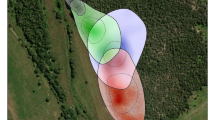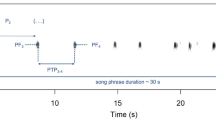Summary
Playback experiments were conducted to determine whether territorial male bullfrogs (Rana catesbeiana) were capable of discriminating between advertisement calls of neighbors and strangers. Territorial males adjacent to subject males were removed and replaced with a speaker which broadcast calls of a stranger or the removed male. Ten of 11 males responded more strongly to calls of strangers than to calls of neighbors. When advertisement calls of neighbors were broadcast to subject males from positions within the removed neighbor's territory and from positions opposite the subject male, all 9 males tested responded more strongly to calls of a neighbor broadcast from a new position than to playbacks of the same call broadcast within the removed neighbor's territory. Because male bullfrogs recognize familiar calls and associate these calls with a particular direction or location, these data provide the first evidence for acoustically mediated neighbor recognition in frogs.
Similar content being viewed by others
References
Armstrong EA (1973) A study of bird song. 2nd ed, Dover Press, New York, NY
Beecher MD (1982) Introduction to the symposium: from individual to species recognition: theories and mechanisms. Am Zool 22:475
Beer CG (1970) Individual recognition of the voice in the social behavior of birds. Adv Study Behav 3:27–74
Beletsky LD (1983) An investigation of individual recognition by voice in female red-winged blackbirds. Anim Behav 31:355–362
Blair WF (1964) Isolating mechanisms and interspecies interactions in anuran amphibians. Quart Rev Biol 39:333–334
Bogert CM (1960) The influence of sound in the behavior of amphibians and reptiles. In: Lanyon WE, Tavolga WN (eds) Animal sounds and communication. Am Inst Biol Sci, Washington, DC, pp 137–320
Brooks RJ, Falls JB (1975a) Individual recognition by song in white-throated sparrows. I. Discrimination of songs of neighbors and strangers. Can J Zool 53:879–888
Brooks RJ, Falls JB (1975b) Individual recognition by song in white-throated sparrows. III. Song features used in individual recognition. Can J Zool 53:1749–1761
Capranica RR (1968) The vocal repertoire of the bullfrog (Rana catesbeiana). Behavior 31:302–325
Emlen ST (1968a) Territoriality in the bullfrog, Rana catesbeiana. Copeia 1968:240–243
Emlen ST (1968b) A technique for marking anuran amphibians for behavioral studies. Herpetologica 24:172–173
Falls JB, Brooks RJ (1975) Individual recognition in whitethroated sparrows. II. Effects of location. Can J Zool 53:1412–1420
Falls JB, McNicholl MK (1979) Neighbor-stranger recognition by song in male blue grouse. Can J Zool 57:457–462
Fisher J (1954) Evolution and bird sociality. In: Huxley J, Hardy AC, Ford EB (eds) Evolution as a process. Allen & Unwin, London, pp 71–83
Gerhardt HC (1973) Reproductive interactions between Hyla crucifer and Pseudacris ornata (Anura: Hylidae). Am Mild Nat 89:81–88
Haas JD (1978) Individual differences in the vocalizations of bullfrogs, Rana catesbeiana. Ph D dissertation, Tufts University, Massachusetts
Harris MA, Lemon RE (1976) Response of male song sparrows Melospiza melodia to neighboring and non-neighboring individuals. Ibis 118:421–424
Howard RD (1978) The evolution of mating strategies in bullfrogs, Rana catesbeiana. Evolution 32:850–871
Hutchison RE, Stevenson JG, Thorpe WH (1968) The basis for individual recognition in the sandwich tern (Sterna sandvicensis). Behavior 32:150–157
Loftus-Hill JJ, Littlejohn MJ (1971) Pulse repetition rate as the basis for mating call discrimination by two sympatric species of Hyla. Copeia 1971:154–156
Myrberg AA, Riggio RJ (1985) Acoustically mediated individual recognition by a coral reef fish (Pomacentrus partitus). Anim Behav 33:411–416
Oldham RS, Gerhardt HC (1975) Behavioral isolating mechanisms of the treefrogs Hyla cinerea and H. gratiosa. Copeia 1975:223–231
Petrinovich L, Peeke HVS (1973) Habituation to territorial songs in the white-crowned sparrow. Behav Biol 8:743–748
Richards DG (1979) Recognition of neighbors by associative learning in rufous-sided towhees. Auk 96:688–693
Searcy WA, McArthur PD, Peters SS, Marler P (1981) Response of male song and swamp sparrows to neighbor, stranger, and self songs. Behaviour 77:152–163
Siegel S (1956) Nonparametric statistics for the behavioral sciences. McGraw-Hill, New York, NY
Thresher RE (1979) The role of individual recognition in the territorial behavior of the threespot damselfish, Eupomacentrus planifrons. Mar Behav Physiol 6:83–93
Weeden JS, Falls JB (1959) Differential responses of male ovenbirds to recorded songs of neighboring and more distant individuals. Auk 76:343–351
Wells KD (1977) The social behavior of anuran amphibians. Anim Behav 25:666–693
Wiewandt TA (1969) Vocalization, aggressive behavior, and territoriality in the bullfrog, Rana catesbeiana. Copeia 1973:276–285
Wiley RH, Wiley MS (1977) Recognition of neighbors' duets by striped-backed wrens Campylorhynchus nuchalis. Behaviour 62:10–34
Wilson EO (1975) Sociobiology: the new synthesis. Belknap Press of Harvard University Press, Cambridge, MS
Wunderle JM (1978) Differential response of territorial yellowthroats to the songs of neighbors and non-neighbors. Auk 95:389–395
Yasukawa K, Bick EI, Wagman DW, Marler PM (1982) Playback and speaker-replacement experiments on song-based neighbor, stranger and self discrimination in male redwinged blackbirds. Behav Ecol Sociobiol 10:211–215
Author information
Authors and Affiliations
Rights and permissions
About this article
Cite this article
Davis, M.S. Acoustically mediated neighbor recognition in the North American bullfrog, Rana catesbeiana . Behav Ecol Sociobiol 21, 185–190 (1987). https://doi.org/10.1007/BF00303209
Received:
Accepted:
Issue Date:
DOI: https://doi.org/10.1007/BF00303209




